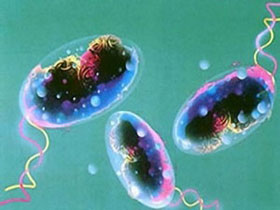Bacteria that move and spread are caused by calcium
US scientists from Chapel Hill Sub-University, University of North Carolina, said they found calcium atoms could control bacterial activity and demonstrated that, after severing special points in the association. Between calcium and protein atoms when the bacteria in the body are involved in movement can paralyze the bacteria.
The results of this new study have found an important step in bacterial infectious residence, while helping scientists to research and invent new drugs to help prevent bacterial infection. Future.
Bacteria can operate and move in liquids based on cilia, and can also take advantage of capillary bacteria to move in solid objects. Because they are able to move both in solid objects and liquids, some bacteria can parasitize in humans, causing people to even die.
 Scientists say bacterial cilia are like hook fishing. When the bacteria move, they first extend the hook to grip the surface of the object, then pull the whole body along. This way of moving them is called muscle movement.
Scientists say bacterial cilia are like hook fishing. When the bacteria move, they first extend the hook to grip the surface of the object, then pull the whole body along. This way of moving them is called muscle movement.
Previous research has shown that a tiny device in a bacterial cell called ATPases, which helps the cysts to expand. When 'starting' the ATPases device will help the ciliary bacteria to elongate, as opposed to 'turning off' the capillary ATPases device. However, people still do not understand the coordinated activity of ATPases in bacterial cells.
Professor Matthew Ruidingbo and colleagues from Chapel Hill Institute conducted a detailed analysis of PilY1 protein in pseudomonas aeruginosa when it was active in humans and identified calcium atoms that could determine behavior. of this bacterium.
In the study, scientists first discovered the X-ray diffraction of PilY1 protein crystals and captured the texture of the protein, further discovering that the specificity in the The combination of PilY1 protein with a single calcium atom can play an important role in controlling protein function.
The scientists then proceeded to change the specific combination of the above points accordingly to see if they would affect the behavior of the protein. When changing to the protein stage that cannot be combined with calcium atoms, scientists observed that at this time bacteria no longer extend the bacteria.
In contrast, when the protein is combined permanently with calcium atoms, the bacteria can extend the cilia, however, they are no longer able to contract and appear paralyzed. This suggests that PilY1 protein must be combined with calcium atoms to extend the cilia, and at the same time force it to escape the calcium atoms to shrink the cilia.
Professor Matthew Ruidingbo argues that the protein of the outer cell shell combined with a single atom is sufficient to command the ATPases device in the cell to perform complex tasks. Currently, scientists are taking advantage of the knowledge of genetics and biochemistry to explain how information transmission in extracellular cells is performed.
- Things you need to know about calcium
- See how fast bacteria spread from the toilet to the human mouth
- The image shows the 'power' that spreads bacteria when sneezing
- How to put calcium in your baby's meals
- Caution should be exercised when taking Calcium tablets
- New mode of spread of deadly bacteria in food
- Climate change facilitates bacterial spread in Northern Europe
- Super rare calcium isotopes: Having $ 500,000 can only buy 2 grams
- There is an uncontrollable spread of bacteria
- Calcium: Popular, safe, and cheap materials can end the era of Li-ion batteries
- The action you must take before you flush the toilet
- Outbreaks of diarrhea caused by bacteria spread in the pool in the United States
 Why do potatoes have eyes?
Why do potatoes have eyes? 'Tragedy' the world's largest carnivorous life: Death becomes ... public toilet
'Tragedy' the world's largest carnivorous life: Death becomes ... public toilet Tomatoes were once considered 'poisonous' for 200 years
Tomatoes were once considered 'poisonous' for 200 years Detecting microscopic parasites on human face
Detecting microscopic parasites on human face